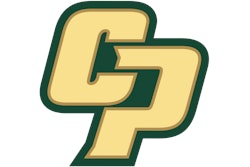Copyright 2017 Dayton Newspapers, Inc.
Dayton Daily News (Ohio)
Illinois defensive back Stanley Green (7) is taken off the field after being ejected for targeting a South Florida player earlier this season.
Targeting penalties in the top tier of college football reached an all-time high this season and the Pac-12 and Southeastern conferences had the most players flagged, according to an analysis of NCAA data and research by The Associated Press.
It has been 10 years since the crackdown started on forcible hits above the shoulders of players determined to be defenseless. This season, the NCAA reported 188 enforced targeting calls in 832 regular-season games of the Bowl Subdivision; that is 30 percent more than last year, when there were 144 in 839 games. The per-game average has risen 35 percent, from 0.17 last year to 0.23 this season. It is the fourth consecutive season that targeting calls have increased.
That might seem alarming, but the increase doesn't indicate a trend of head-hunting in the sport, said Rogers Redding, the NCAA's national coordinator of officials. He attributed the increase to officials getting better at detecting the penalty, more willingness of replay officials to call fouls missed on the field and the expanded definition of what constitutes a defenseless player.
The calls may be up, but play is likely safer.
"Players are getting their head out of it, they're lowering their strike zone, you don't see as much of a launch, but you still see a crouch and upward thrust," he said. "Even though the numbers are up, the player behavior overall has changed."
The NCAA compiles its numbers through reports submitted each week by conferences. A conference report includes any targeting call made by its officiating crews, even if the penalty was against an opponent from another conference. The NCAA report, therefore, would not always reflect the actual number of targeting fouls committed by players in a particular league.
The AP verified the circumstances of 176 targeting calls this season through official play-by-play sheets, media accounts and with the assistance of school and conference sports information directors.
The SEC confirmed 27 instances of its players being flagged for targeting but declined to provide details of five calls not reported on play-by-play sheets or by the media. In all, the AP could not account for seven targeting penalties out of the 188 reported by the NCAA.
Among the AP's findings:
* The Pac-12 had a nation-high 30 targeting calls against its players, with UCLA and Utah having five apiece.
* Five other FBS schools had five targeting calls: Akron, New Mexico State, Ohio State, Temple and Texas A&M.
* Akron cornerback Alvin Davis Jr. was flagged for targeting three times, most in the nation, and seven other players were each flagged twice.
* On 152 running or passing plays when targeting occurred, 46 calls were against safeties, 43 against defensive linemen, 33 against linebackers and 20 against cornerbacks.
* Of the 176 verified calls, 113 occurred on pass plays, 39 on runs, 21 on kickoffs or punts, and one each on a point-after touchdown, 2-point conversion try and field-goal attempt.
* More than half of the possessions in which targeting was called ended with a score for the offended team - 83 touchdowns, 18 field goals.
* Targeting most often occurred on first down (59 times).
The 14-team Atlantic Coast Conference had only six enforced targeting calls. Redding said differing styles of play can lead to variances across conferences, but he said the ACC figure was surprisingly low and he initially thought it was the result of a reporting error.
ACC coordinator of football officiating Dennis Hennigan said it's no mistake. He credited league coaches for doing a good job of teaching proper tackling technique and what's legal, and the players for adapting to targeting rules. Hennigan said he was satisfied with how his officiating crews performed.
"I don't know if it was the luck of the draw this year, but we simply didn't have a lot of targeting in our conference. Just one of those years," he said. "Obviously, I hope that (ACC) trend continues."
Todd Berry, executive director of the American Football Coaches Association, also noted the disparity between the ACC and the Pac-12 but said one year is too small a sample.
"If those numbers come back, we need to look at, 'Is the Pac-12 officiating it right or is the ACC not officiating it right?'" Berry said. "We need to look at several years of data."
The targeting penalty was introduced in 2008 not just because of growing concerns about the sport's concussion risk but also as a response to research showing catastrophic head, neck, spine and brain injuries at all levels of football spiked in the 2000s.
Targeting initially was a personal foul, but starting in 2013 it resulted in a player ejection, and since then all targeting calls are subject to video review and can be overturned. In 2016, replay officials were given the discretion to call targeting fouls missed by field officials, and this year their charge expanded to stopping the game to call any targeting foul they see.
The number of calls initiated by replay officials more than doubled this year, from 22 to 57. Redding also pointed out that in the past two years the definition of a defenseless player has expanded to include a sliding ball-carrier and a player who is blocked from his blind side.
"That opens it up for more susceptibility for more targeting fouls," he said.
Redding said the NCAA Football Rules Committee sees no need to change the rule at this point.
"My advice to the committee is going to be let's not mess with this now," he said. "Let's let this sit and bake for a while. I think we need to get everyone used to where the rule is."
Read More of Today's AB Headlines
Subscribe to Our Daily E-Newsletter
Terms and Conditions Privacy Policy



































